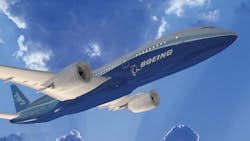The U.S. Federal Aviation Administration is citing a manufacturing error at Boeing Commercial Airplanes assembly plants as its reason for requiring a mandatory inspection round for Boeing’s 787 jets. The inspections had previously been “recommended” by FAA.
In September, the National Transportaton Safety Board ordered inspections to GE Aviation’s GEnx-1B and GE-nx-2B after the discovery of cracks in two engine shafts on two Boeing 787 Dreamliners.
The new inspection order seeks to resolve a problem with leaks in the fuel-line couplings of the Dreamliners’ engine pylons, leaks that FAA has traced to a flaw in the manufacturing process at one of Boeing’s plants. It is requiring operators to check for incorrectly installed lockwires on the engine fuel line couplings within seven days, and within 21 days operators must inspect the couplings to verify they have been assembled correctly.
According to Boeing, if the fuel line connectors are not installed properly the aircraft could experience fuel leaks, loss of engine power, or fire.
However, the jet builder said the 787 is designed with "multiple layers of systems to ensure none of those things happen."
It’s not known if a fuel leak was the reason that a 787 flown by United Airlines from Houston was forced to make an emergency landing in New Orleans on Tuesday, December 3. Reportedly, the plane had been in service for only two weeks. There were no injuries to the 184 passengers and crew on board. They were transferred to another jet and completed their route to Newark.
United is the only U.S. carrier flying 787s. All Nippon Airways has 16 Dreamliners in service, and orders with Boeing for up to 50 more, almost half of all the new jets in commercial service.
About the Author
Robert Brooks
Content Director
Robert Brooks has been a business-to-business reporter, writer, editor, and columnist for more than 20 years, specializing in the primary metal and basic manufacturing industries.
